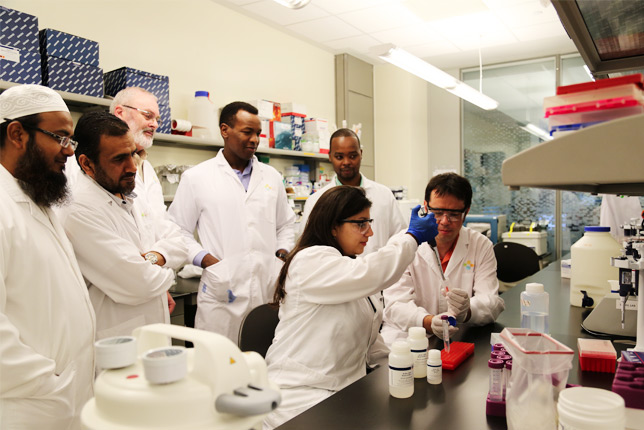Genome analysis reveals unique features of bacterium isolated from Red Sea

Jimenez-Infante, Prof. Ulrich Stingl and the team of researchers from the RSRC and KAUST’s Computational Bioscience Research Center (CBRC)
“It is exciting how genomes can tell us much about the lifestyles and ecology of microbes,” said Francy Jimenez-Infante, a KAUST Ph.D. student in the University’s Red Sea Research Center (RSRC). Jimenez-Infante, a founding class student who completed her Master’s Degree in bioscience at KAUST in 2010, decided to pursue her Ph.D. at the University after becoming fascinated with the microbial ecology of the oceans. “I wanted to conduct more ambitious research projects in the Red Sea,” she said.
Jimenez-Infante and a team of researchers from the RSRC and KAUST’s Computational Bioscience Research Center (CBRC) examined the genetic makeup of a low-abundant bacterium called strain RS24 that lives in the euphotic, or uppermost layer, of the Red Sea. Their study was recently published in FEMS Microbiology Ecology (Volume 89, issue 1, pages 181-197, July 2014).
Organisms making up the so-called “rare biosphere” of the world’s marine ecosystems comprise less than 1 percent of the bacterio-plankton communities in these environments, but are extremely diverse, playing an important role in the functioning of marine food webs.
UNDERSTANDING HOW ORGANISMS ADAPT
The researchers wanted to discover how the organisms adapt to different environments, which might in turn provide more of an understanding of their essential role in the world’s ocean. To do this, they isolated RS24 from the surface waters of the Red Sea and sequenced and analyzed its genome.
“The Red Sea is an unusual marine habitat with high temperatures and high salinity,” explained Ulrich Stingl, KAUST Assistant Professor of Marine Science in the RSRC. “Its peculiarities make it an interesting model in which to study microbial community structure-function relationships, and, because it has relatively extreme conditions, we postulated these conditions should have an impact on the genomes of resident organisms.”
Through ribosomal RNA (rRNA) gene-based analyses, the team discovered that strain RS24 belongs to a clade called PS1. In biology, a clade is group of organisms that are more closely related to each other than any other group and share a common ancestor. The PS1 clade is part of the class Alphaproteobacteria. Because RS24 is the first isolate from PS1 found in the Red Sea near the Saudi village of Thuwal, the researchers proposed to name it Candidatus Micropelagos thuwalensis RS24.
Prior to the team’s research work, only one other isolate called IMCC14465 had been cultured from the PS1 clade. Isolate IMCC14465 was discovered in the lower temperature and salinity waters of the East (Japan) Sea, and its draft genome was published in 2012.
Sequencing data revealed that although RS24 and IMCC14465 have very similar genomes, they are actually two distinct species of the PS1 clade. The two contain “genomic islands” that enable IMCC14465 to degrade aromatic compounds and allow RS24 to degrade polymers. These differences “possibly [reflect] the physiochemical differences in the environment [each was] isolated from,” the researchers state.
GENE-BASED PHYLOGENY RESEARCH
The researchers also examined a gene-based phylogeny for proteorhodopsin (PR) in RS24 and IMCC14465. Proteorhodopsins are trans-membrane proteins found in microorganisms that help to absorb light, generating energy to move ions through light-driven proton pumping.
They found that the gene-based phylogeny for proteorhodopsin in RS24 and IMCC14465 was distinct, and predicted that RS24 has a blue-tuned PR (BPR; absorbing light at 490 nm), whereas IMCC14465 has a green-tuned PR (GPR; absorbing light at 525 nm). This is consistent with pervious discoveries reporting a predominance of BPRs in oligotrophic open-ocean waters such as the Red Sea and the Sargasso Sea, which have relatively low nutrient concentrations and low plant growth. The type of PR also corresponds to the ambient light available for each organism in the East (Japan) Sea and the Red Sea, respectively.
The researchers knew that concentrations of essential nutrients and trace micronutrients, which are very important for cell growth, are found in low amounts in most of the global ocean. Genome examination revealed that the PS1 clade strains’ genomes encode many high-affinity transporter genes, a “genomic hallmark” for cells that live in low-nutrient environments (like the Red Sea). These genes include high-affinity transport systems for zinc, phosphate, ammonium, and iron, for example. Other genes code for high-affinity nutrient acquisition systems, which may be essential for the organisms to survive in low-nutrient environments where they must make use of many different substrates to grow.
ANSWERING CRITICAL QUESTIONS ABOUT ECOLOGY
Prior to the team’s work, little was known about the roles of the PS1 clade’s isolates in the oceans. The successful cultivation of the RS24 species “helps to answer critical questions about their ecology and provides insights on the role of low-abundance organisms in today’s oceans,” the researchers state.
“We were surprised to find that the genomes from isolates of the same group found in the two very different environments of the Red Sea and East Sea were so similar,” said Prof. Stingl. “They differ in only a few genes that might be responsible for their success in each environment.”
Adds Jimenez-Infante, “Thanks to the analysis of whole genomes, features in similar bacteria isolated from different and geographically separated environments can reveal certain adaptations to their specific habitats that cannot be revealed based on single gene analysis alone.”
She feels that the team’s “efforts on isolating, identifying, and understanding the microbes from the Red Sea are helping us to comprehend how microorganisms can successfully adapt to harsh conditions.” And, because “the Red Sea is just around the corner from KAUST waiting for us to explore it, we have all the tools and resources necessary for us to make further discoveries about these organisms,” she says.
- By Caitlin Clark, KAUST News

